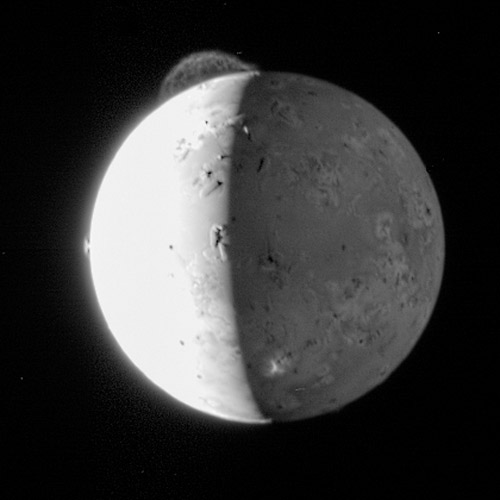Mystery of Io's Atmosphere Solved

Jupiter'svolcanic moon Io is veiled by a thin atmosphere, but how much its volcanoes andchunks of frozen gas contribute to its atmosphere has puzzled scientists fordecades.
The NewHorizons spacecraft recently documented the moon's glowing aurora, however,giving researchers a chance to solve the atmospheric mystery.
Io is the mostvolcanically active object in the solar system. The moon's pockmarked andcolorful appearance is not unlike a pepperoni pizza.
?Iois volcanically active, and that volcanism ultimately is the source materialfor Io?s sulfur-dioxide atmosphere," said Kurt Retherford, a spacescientist at the Southwest Research Institute in San Antonio. "But therelative contributions of volcanic plumes and sublimation of frosts depositednear the plumes have remained a question for almost 30 years.?
Io'svolcanoes spew out sulfur dioxide, which is a gas that stinks of freshly litmatches and almost entirely makes up the moon's atmosphere. As Io rotates fromdaylight into darkness, chilling the yellowish rock down to -226 F (-143 C),the gas freezes into a solid, much like dry ice (frozen carbon dioxide gas).
"Theatmosphere at that point collapses down so that all that is left supplying theatmosphere are the volcanoes,? Retherford said.
BecauseIo's volcanic gas stays warm enough not to freeze and creates glowingauroras, scientists were able to find out how much the volcanoes supplyIo's atmosphere by measuring the moon's nightside aurora.
Breaking space news, the latest updates on rocket launches, skywatching events and more!
About 1 to3 percent of Io's dayside atmosphere, it turns out, is created by thevolcanoes. The rest is generated from frozen sulfur dioxide turning directlyinto gas which, over eons, has accumulated on Io's surface.
NewHorizon's used its Alice ultraviolet spectrograph to capture images of Io'sauroras on thespacecraft's way to Pluto, which mission scientists expect to reach in2015. Retherford and his colleagues' findings based on the Alice data aredetailed in a recent issue of the journal Science.
- The Wildest Weather in the Galaxy
- GALLERY: Jupiter's Moons
- VIDEO: Passport to Pluto
Dave Mosher is currently a public relations executive at AST SpaceMobile, which aims to bring mobile broadband internet access to the half of humanity that currently lacks it. Before joining AST SpaceMobile, he was a senior correspondent at Insider and the online director at Popular Science. He has written for several news outlets in addition to Live Science and Space.com, including: Wired.com, National Geographic News, Scientific American, Simons Foundation and Discover Magazine.
